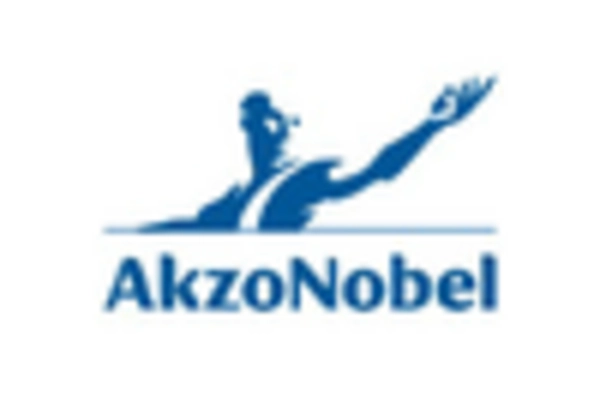Rising Consumer Expectations
Rising consumer expectations regarding product performance and safety are driving the antimicrobial powder-coating market. As consumers become more discerning, they seek products that not only meet aesthetic standards but also provide added value through enhanced safety features. This trend is particularly pronounced in sectors such as consumer goods and electronics, where antimicrobial coatings can prevent the growth of harmful bacteria on surfaces. Manufacturers are increasingly recognizing the need to incorporate these coatings into their products to meet consumer demands. The antimicrobial powder-coating market is likely to experience growth as companies strive to differentiate their offerings and enhance consumer trust. Market analysis suggests that this shift in consumer behavior could lead to a growth rate of around 7% in the coming years.
Increased Awareness of Hygiene
The growing awareness of hygiene and cleanliness among consumers is a pivotal driver for the antimicrobial powder-coating market. As individuals become more conscious of the importance of maintaining sanitary environments, particularly in public spaces, the demand for antimicrobial coatings is likely to rise. This trend is particularly evident in sectors such as healthcare, food processing, and hospitality, where the need for surfaces that inhibit microbial growth is paramount. The antimicrobial powder-coating market is projected to benefit from this heightened focus on hygiene, with estimates suggesting a potential growth rate of around 8% annually in the coming years. This increasing consumer awareness is expected to drive manufacturers to innovate and expand their product offerings, thereby enhancing the overall market landscape.
Expansion in Construction Industry
The expansion of the construction industry in the United States serves as a significant driver for the antimicrobial powder-coating market. With the construction sector experiencing a resurgence, there is a growing demand for materials that not only provide aesthetic appeal but also offer functional benefits such as antimicrobial properties. This is particularly relevant in commercial buildings, schools, and healthcare facilities, where the need for durable and hygienic surfaces is critical. The antimicrobial powder-coating market is likely to see increased adoption as builders and architects prioritize materials that enhance safety and cleanliness. Recent data indicates that the construction industry is expected to grow by approximately 5% annually, which could translate into substantial opportunities for antimicrobial coatings in various applications.
Technological Innovations in Coating Processes
Technological innovations in coating processes are emerging as a crucial driver for the antimicrobial powder-coating market. Advances in application techniques, such as electrostatic spray deposition and fluidized bed coating, are enhancing the efficiency and effectiveness of antimicrobial coatings. These innovations not only improve the adhesion and durability of coatings but also expand their applicability across various substrates. As manufacturers adopt these advanced technologies, the antimicrobial powder-coating market is likely to witness increased production capabilities and reduced costs. This could potentially lead to a broader adoption of antimicrobial coatings in diverse industries, including automotive, aerospace, and consumer products. The market is expected to grow as these technological advancements facilitate the development of more effective and versatile antimicrobial solutions.
Regulatory Initiatives Promoting Safety Standards
Regulatory initiatives aimed at promoting safety standards are playing a vital role in shaping the antimicrobial powder-coating market. Government agencies are increasingly implementing regulations that require the use of antimicrobial coatings in specific applications, particularly in healthcare and food service environments. These regulations are designed to enhance public health and safety by minimizing the risk of microbial contamination. As a result, manufacturers are compelled to comply with these standards, leading to a surge in demand for antimicrobial coatings. The antimicrobial powder-coating market is likely to benefit from these regulatory frameworks, which could drive growth rates of approximately 6% in the coming years. This regulatory support not only encourages innovation but also fosters a competitive landscape where companies strive to meet and exceed safety expectations.

















Leave a Comment